




MUSEUM OF INDIAN ARTS AND CULTURE
MUSEUM OF INTERNATIONAL FOLK ART
NEW MEXICO MUSEUM OF ART
NEW MEXICO HISTORY MUSEUM
NEW MEXICO HISTORIC SITES OFFICE OF ARCHAEOLOGICAL
Cover: Roman Selivachov, Повелителька дронів (Lady of the Drones), 2024. Wood from ammunition box, egg tempera, gold leaf. Courtesy of the artist. From the exhibition Amidst Cries from the Rubble: Art of Loss and Resilience from Ukraine at the Museum of International Folk Art.
Above: A Native dancer performs at the Native Treasures Art Market. Photo © Jason Ordaz.
Opposite: Photo by Saro Calewarts.
The Museum of New Mexico Foundation supports the Museum of New Mexico system, in collaboration with the Museum of New Mexico Board of Regents and the New Mexico Department of Cultural Affairs. The Foundation’s principal activities are fund development for exhibitions and education programs, retail and licensing programs, financial management, advocacy and special initiatives.
We serve the following state cultural institutions:
• Museum of Indian Arts and Culture
• Museum of International Folk Art
• New Mexico History Museum
• New Mexico Museum of Art
• New Mexico Historic Sites
• Office of Archaeological Studies
Mariann Lovato, Managing Editor
Carmella Padilla, Writer and Editor
Steve Cantrell, Writer
Jennifer Levin, Writer
Saro Calewarts, Designer
Dear Members,
Since its inception in 1909, the Museum of New Mexico has provided a platform for the public exploration, exhibition and education of New Mexico’s vast cultural resources. From the earliest artists, archaeologists, scholars and visitors attracted by our state’s deep history and diversity, to the generations of New Mexicans whose stories and experiences the system reflects, our local-global perspective on the world is unique.
In this issue of Member News, we look at the innovative ways the staff at our four state museums in Santa Fe, eight historic sites statewide and the Office of Archaeological Studies is stewarding these resources in innovative ways. You’ll read how, both individually and collaboratively, our institutions are reflecting the intersections in art, culture and history that continue to make New Mexico an international destination while fulfilling a mission of excellence for the benefit of all New Mexicans.
Fall is a wonderful time to enjoy the fruits of their professional labors, as the 2024 exhibition and activity calendar enters its final stages before the holiday season. Last month, we celebrated the much-anticipated opening of the new JoAnn and Bob Balzer Native Market and Contemporary Art Gallery at the Museum of Indian Arts and Culture. Its inaugural exhibition, Driving the Market: Award-Winning Native Contemporary Art, featuring works from over 45 artists, is a perfect example of how our museums connect artists and collectors in culturally meaningful ways that impact generations. It’s inspiring.
Other local collectors are helping foster international connections at the Museum of International Folk Art, where the opening of iNgqikithi yokuPhica/Weaving Meanings: Telephone Wire Art from South Africa takes center stage November 17. Through the generosity of David Arment and Jim Rimelspach, who donated Arment’s collection of nearly 400 world-class examples of South African telephone wire basketry, the museum has dramatically increased its African collection for the education of its visitors. You won’t see a collection like this anywhere else in the world.
Public education, outreach and enjoyment are also driving fall events at our historic sites, including the Los Luceros Harvest Festival. The New Mexico History Museum asked the public for New Mexico restaurant memories to spice up its latest exhibition, Forks in the Road: A Diner’s Guide to New Mexico. And an array of artist-centered, donor-supported conversations and presentations are in line for both fall and spring at Vladem Contemporary.
It takes a village, as they say, and members and donors like you are part of our extraordinary circle of art, culture, history and education. Thank you for all you do to keep the Museum of New Mexico moving forward.
Sincerely,
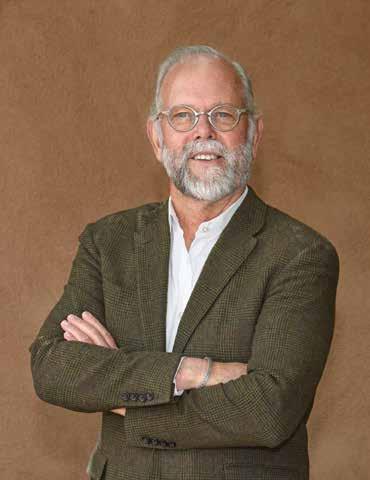
It takes a village, as they say, and members and donors like you are part of our extraordinary circle of art, culture, history and education.
—Jamie Clements
Jamie Clements President/CEO

The Museum of New Mexico Foundation welcomes Michael Knight (pictured left with Foundation President/CEO Jamie Clements) as incoming chair of our Board of Trustees. Knight, who previously served as board treasurer, has also been active on the executive and finance committees.
Knight has more than 30 years of experience working in professional services firms globally. Most recently, he was the managing director of client management services at Wellington Management Company, a Boston-based asset management firm serving institutional clients around the world. In addition to working with the Foundation, he enjoys spending time cooking for his family, flyfishing and walking his dog.
As Knight assumes his new role, the Foundation extends tremendous gratitude to our outgoing board chair, Frieda Simons. Simons served for two years and will remain active on the board as chair of our Governance Committee.
Michael Knight, Chair
Nancy Baker,Vice Chair
Dan Monroe,Vice Chair
John Macukas, Treasurer
Edelma Huntley, Secretary
VOTING TRUSTEES
Allan Affeldt
Cathy Allen
David Arment
Nimish Bhatt
Caroline Burnett
Elaine Cole
Joe Colvin
Diane Domenici
Greg Dove
John Duncan
Kirk Ellis
Deborah Fritz
Robert Glick
Carmen Gonzales
J. Scott Hall
Pat Hall
Marilyn Harris
Susie Herman
Ruth Hogan
Peggy Hubbard
Robert Jones
Bruce Larsen
Christine McDermott
Dee Ann McIntyre
Kate Moss
Patty Newman
Michael Ogg, M.D.
Dennis A. O’Toole, Ph.D.
Sara Otto
Sabrina Pratt
Michael Reid
Natalie Rivera
Wilson Scanlan
ADVISORY TRUSTEES
Victoria Addison
Keith K. Anderson
Cynthia Bolene
Julia Catron
Stockton Colt
Jim Davis
Joan Dayton
Gwenn Djupedal
Maria Gale
Carlos Garcia
Leroy Garcia
Stephen Hochberg
Rae Hoffacker
Barbara Hoover
Kent F. Jacobs, M.D.
David Matthews
Helene Singer Merrin
Beverly Morris
Mark Naylor
Jane O’Toole
Michael Pettit
Judy Sherman
J. Edd Stepp
Robert Vladem
Nancy Meem Wirth
Claire Woodcock
HONORARY TRUSTEES
Anne Bingaman
William Butler
Jim Duncan Jr.
John Marion
Eileen A. Wells
Above: Photo by Saro Calewarts.
Opposite top: Velino Shije Herrera, Ma Pe Wi (Zia Pueblo), Buffalo Dance, ca. 1922. Collection of the Museum of Indian Arts and Culture, courtesy John and Linda Comstock and the Abigail Van Vleck Charitable Trust. Photo © Addison Doty.
Opposite middle: Victor Higgins, Untitled (Adobe House with Woman in Red), n.d. Collection of the New Mexico Museum of Art, gift of the Joan Higgins Reed Estate, 1984. Photo by Blair Clark, courtesy New Mexico Museum of Art.
Opposite bottom: Model wearing dress designed by Patricia Michaels (Taos Pueblo). Photo © Tira Howard.
Frieda Simons
Courtney Finch Taylor
Margo Thoma
Elmer Torres
Laura Widmar
Madeleine Wright
Sandy Zane
TRUSTEES EMERITI
Saul Cohen
Rosalind Doherty
Bud Hamilton
Jerry Richardson
James Snead

“Some people are under the impression that we’re an art museum,” says Tony Chavarria, curator of ethnology at the Museum of Indian Arts and Culture. “But particularly in Native pueblo culture, art isn’t separate from everything else.”
Chavarria’s holistic perspective on the natural intersections of history, culture and everyday life is central to the mission of the museum he represents. “Everything we do promotes the culture, lifeways and art of the Native people of the American Southwest. It’s even reflected in our name,” he says.
Those intersections also flow throughout the Museum of New Mexico system, whose diverse cultural resources represent both tangible and intangible aspects of the state’s land and peoples. From contemporary art to ancient artifacts, cutting-edge research to items that reflect generational migrations and creations, our institutions engage audiences in the complexity of the New Mexican experience through time. They also work together to share our statewide story and its international significance with the world.
It’s a robust approach to conserving and communicating culture that includes exhibitions, access to rare archives and an array of educational opportunities for the public. But creating and maintaining such programming is expensive.
“Private support through the Museum of New Mexico Foundation is critical to institutional stewardship of these resources,” says Jamie Clements, Foundation president and CEO. “When people learn about the innovative ways that our divisions are utilizing these resources, it’s a compelling reason to give.”E
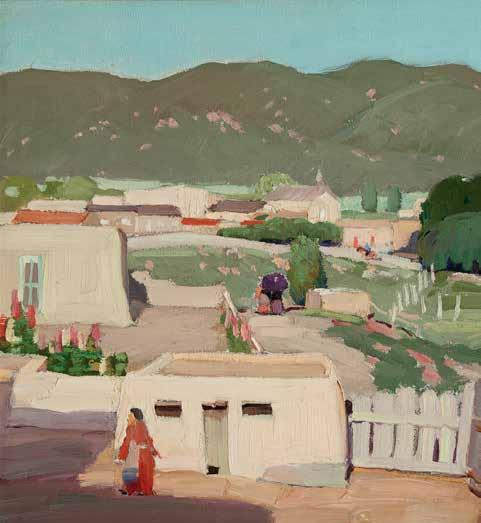

The Museum of Indian Arts and Culture opened in 1987 to showcase the holdings of the Laboratory of Anthropology, a research library founded in 1927 that later became part of the Museum of New Mexico. While the museum hosts fantastic exhibitions about Native lifeways, like its permanent display of Here, Now and Always, as well as eye-catching contemporary exhibitions like Painted by Hand: The Textiles of Patricia Michaels, Chavarria explains, “About 99 percent of our collections are archaeological, because we’re the mandated repository for materials that are being excavated in the state. There’s treasure as well as soil samples, rocks and things like that.”
The museum collaborates closely with the Office of Archaeological Studies, where Thatcher Seltzer-Rogers heads up a world-renowned ceramic analysis laboratory. Seltzer-Rogers says that pottery fragments from the museum’s archaeological collection “are vital to understanding the development of complex societies in the Southwest. Analyzing broken pots allows me to investigate intriguing questions, from identifying ethnic groups, to how they exchanged materials and ideas, to how they learned to shape and paint pots.”
The Office of Archaeological Studies conducts research projects statewide. It also provides ethnographic and historical research services through five specialized laboratories, including one for low-energy plasma radiocarbon sampling, which is considered the most precise dating system in use worldwide. While rooted in New Mexico archaeology, all lab research has global educational value, often attracting international clients.
Folk art collector and philanthropist Florence Dibell Bartlett founded the Museum of International Folk Art in New Mexico because folk art is understood and respected among local communities whose own folk art practices and traditions span centuries.
“In the museum world, it can be a struggle to get across how folk art is related to the fine art world. An exhibition of pottery or rugs can require weeks of additional educational programming,” says deputy director Laura Meuller. “We don’t have that baggage. We get to move immediately into the heart of what people have created.”
As a result, the museum seamlessly engages both local and global folk art as traditions with international meaning. For example, Mueller co-curated Amidst Cries from the Rubble: Art of Loss and Resilience from Ukraine, on view in the museum’s Gallery of Conscience until April 2025. Works are by artists and others who turned to art to process Russia’s 2022 invasion of Ukraine. Shipping art out of a war zone required creative international delivery routes and artistic flexibility. To get her mixed-media fiber painting through customs, one artist removed 200 found bullet casings, located a U.S. source for the same casings, and then re-created the piece at the museum just days before the exhibition opened.
A demonstration of spear point carving is among the many educational activities offered by the Office of Archaological Studies during public events at the Center for New Mexico Archaeology. Photo by Saro Calewarts.
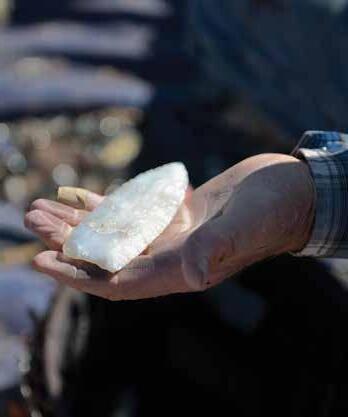
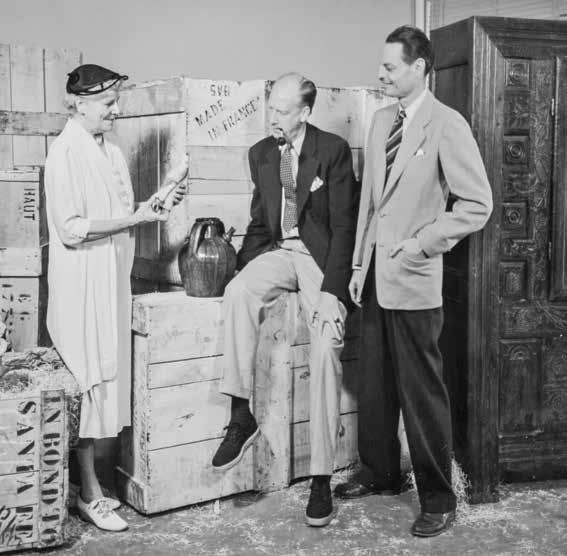
Museum of International Folk Art founder Florence Dibell Bartlett pictured in 1953 with French Consul Paul Coze (middle) and museum director Robert Bruce Inverarity. Photo courtesy Museum of International Folk Art.
Museum visitors view works at the opening of Amidst Cries from the Rubble: Art of Loss and Resilience from Ukraine, now on view at the Museum of International Folk Art. Photo © Cousineau Studios.
“We’re talking about life, death and destruction in a war that’s currently being fought,” Mueller says. “The exhibition is hard-hitting. But we don’t want people to walk out feeling helpless. These works are amazingly beautiful, and they convey hope—a reason to continue to fight for what you believe in and to move forward.”

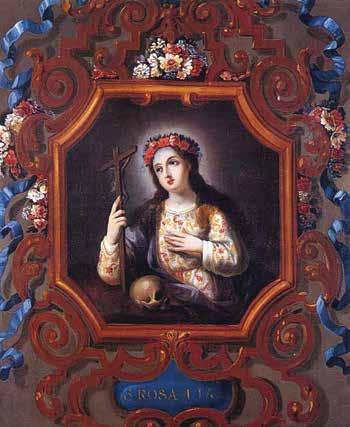
Closer to home, the museum is a repository for a wealth of New Mexican and American folk art. The collections staff recently took on oversight of 3,000 pieces of religious art, textiles, furniture and other objects held at the Taylor-Mesilla Historic Site in southern New Mexico, which is slated to open in fall 2025.
“The objects help us understand and appreciate the history, culture, and traditions of Mesilla and the Southwest borderlands,” says Charlie Lockwood, the folk art museum’s executive director. “We’re excited about potential collaborations with historic sites and other local partners that feature this remarkable collection, assembled and cared for by J. Paul and Mary Daniels Taylor and the Taylor family over many decades.”
The state’s eight historic sites offer opportunities to walk in the footsteps of important cultural figures while learning about multiple historical eras in New Mexico that often influenced world history and events. All the sites offer self-guided and ranger-guided tours, creative activities, seasonal festivals and natural beauty via hiking trails. Some even offer summer camp programs for kids, turning history from a school subject into an immersive experience.
The New Mexico Museum of Art also houses a collection that is simultaneously hyperlocal and boundlessly international. Many of the museum’s original artists were modernists with global reputations.
“We think of so many of these artists as ‘our folks,’ like Gustave Baumann or Eugenie Shonnard. But, at least for the last century, New Mexico has been a national and international destination for artwork,” says Christian Waguespack, head of curatorial affairs and curator of 20th century art. “A lot of it is religious material—santero traditions from Mexico—but when it landed in New Mexico, it evolved into its own distinctive visual style.”
Though the museum does not focus on collecting traditional santos, a current exhibition engages stories of New Mexico’s cross-cultural pollination with the international narrative of New Spain. Visitors can dive into the topic in Saints & Santos: Picturing the Holy in New Spain, on view at the museum’s downtown Plaza Building through January 2025. Waguespack adds that Shonnard, a sculptor who donated her Santa Fe home and studio to the Museum of New Mexico Foundation, was a favored student of Alphonse Mucha, the father of art nouveau. From Mucha to Manga, an upcoming traveling exhibition of alternative art genres that he influenced, will be on view at the Vladem Contemporary in summer 2025, paired with a Shonnard exhibition at the Plaza Building.
“I never thought there would be an opportunity to show someone like Mucha at the New Mexico Museum of Art, but the more we understand our collection, the more connections we can make,” Waguespack says.
Waguespack’s first stop when researching New Mexico artists is the museum’s library and archives, which is a repository for artists’ journals and correspondence, among other items. His next research avenue is the Palace of the Governors Photo Archives at the New Mexico History Museum, which contains close to a million photographs, negatives, prints and digital images. He never knows when he’ll stumble onto new information, because the archive always reveals new treasures.
“We only have estimates on the total number [of holdings], because not everything is catalogued,” says photo archives curator Hannah Abelbeck. Although databases are digital, input is manual and quite detailed. A perpetual backlog of uncatalogued items haunts every museum curator throughout the Museum of New Mexico system. The issues are usually staffing, time and funding.
“This is an area for which we need support,” says Chavarria of the Museum of Indian Arts and Culture. “Often, funding for digitization and collections care must be raised. We’re getting more and more bequests from an era of collectors who are passing on, and these items just sit in storage instead of getting processed and given a permanent location.”
Located across from the Santa Fe Plaza, the New Mexico History Museum is a landmark for New Mexicans and a top destination for visitors from around the world. The institution is currently focused on utilizing one of the state’s most important cultural resources—the crucial memories held by people and communities that tell New Mexico’s most intimate stories.
“These are oral histories as well as physical objects, which can be as big as the Palace of the Governors or as small as a horn that’s been shaped to be a cooking ladle,” says the museum’s executive director Billy Garrett.
Reflections on History, on view through April 2025, is a photography exhibition that challenges visitors to transcend the boundary between past and present. “I wanted people to see themselves within history, so mirrors are incorporated into the space that allow you to project yourself into the images,” says deputy director Catherine Trujillo.
An ongoing exhibition, Palace Through Time, invites visitors to understand how the building has changed over hundreds of years. Guests walk through a touchable, 20-foot time grid and eight 3-D printed models of the Palace as researchers believe it stood at 50-year increments, based on historical documents.
“We have sketched plans, verbal descriptions and rough outlines on a map. Some information goes back to 1650,” Garrett says. “It’s as close as you can get to time travel.”
“The collective history of all our institutions is vital to New Mexico’s future as a center for art and culture,” adds Foundation CEO Clements. “Members’ support today will make possible tomorrow’s innovation.”
Top: A volunteer works in the library at the New Mexico Museum of Art. Photo by Saro Calewarts.
Bottom: A visitor examines Reflections on History now on view at the Palace of the Governors. Photo © Chloe Accardi.
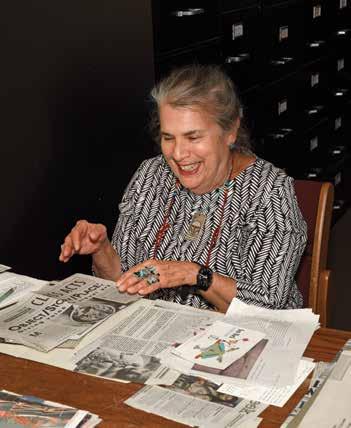
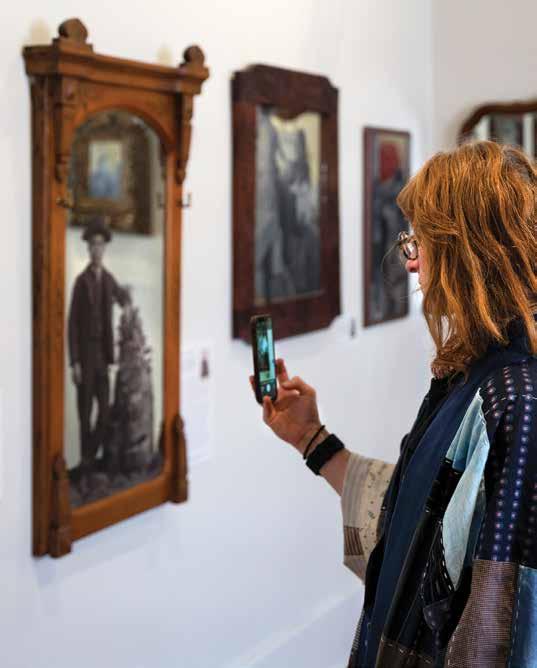
Mohawk Group, a Museum of New Mexico Foundation licensee, is revisiting and expanding its Celebrated Heritage carpet collection inspired by the collections of the Museum of Indian Arts and Culture and Museum of International Folk Art.
Initially launched in 2021 and comprised of four patterns based on pottery, basketry and textiles, the new items feature updated color lines. Additionally, a new style called Woven Traditions has been added to further share the storied traditions of pottery, basketry and textile weaving by Indigenous artists of North America.
As with all our partnerships, Mohawk’s design team collaborated with the museum to thoughtfully reinterpret hand woven basket designs into a new machinetufted carpet pattern. Fusing Native craftsmanship with contemporary technology, the new pattern reflects both the essential qualities of this craft tradition and its evolution into a modern design.

The new Woven Traditions style was inspired by two Northwest Coast baskets in the Museum of Indian Arts and Culture collection. The name of the new pattern references the structural elements of basket making and the natural materials used in its construction.
This complete soft surface portfolio has a variety of constructions, textures and pattern scales to appeal to a broad range of spaces and projects. The aim of this collection is to share the vitality of living artistic traditions and the people who produce and maintain this rich celebrated heritage.
A portion of the proceeds from Celebrated Heritage supports both the Museum of Indian Arts and Culture and Museum of International Folk Art in their mission to preserve and promote the artistic and craft traditions of the world’s artisans.
Established in 1998, the Foundation’s licensing program forges creative partnerships with manufacturers worldwide to develop new products inspired by cultural material and fine art in the collections of the four state museums in Santa Fe. In exchange for providing collections access to manufacturers, the Foundation receives a royalty, or percentage, of the product’s wholesale price. Revenues provide vital financial support for the Foundation and for the museums that are at the heart of its mission. For more information, visit mnmlicensing.org.
Top and background: Woven Tradition carpet tile, from Mohawk Group’s Celebrated Heritage collection.
Bottom: Artist once known, Carrying bag, ca. 1920, Unangan. From the collection of the Museum of Indian Arts and Culture, the carrying bag was the inspiration piece for the carpet tile.


The August opening of the new JoAnn and Bob Balzer Native Market and Contemporary Art Gallery at the Museum of Indian Arts and Culture was a highlight of this year’s Indian Market week in Santa Fe.
It was a fitting marriage of events, as few know Indian Market as well as the Balzers. In addition to being longtime supporters of the museum, the couple says they “have attended Santa Fe Indian Market for more than 50 years straight, and we always gravitate toward collecting contemporary art.”
A major $500,000 gift from the Balzers via the Museum of New Mexico Foundation spurred the creation of the much-anticipated new gallery. The couple explained their motivation behind the gift, saying, “We wanted to cultivate a deeper appreciation for contemporary Native American art and established this dedicated gallery for showcasing the remarkable diversity and innovation found at the Santa Fe Indian Market and other Indigenous markets.”
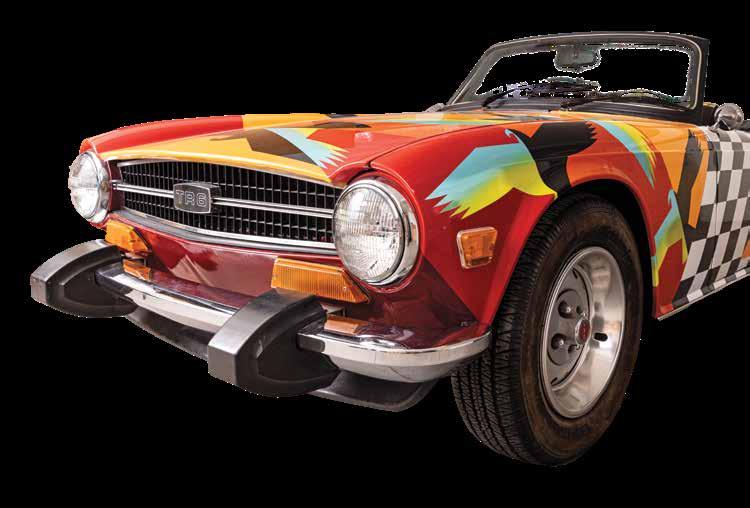
The inaugural exhibition, now on view, underscores that desire. Driving the Market: Award-Winning Native Contemporary Art celebrates the artists who are central to Indigenous markets. From pottery and textiles to cuttingedge digital art, the exhibition offers a comprehensive look at a vibrant range of creativity, with half of the works coming from the museum’s collection and the other half on loan. A video installation highlights artist and stakeholder perspectives on the role that markets play in supporting contemporary Native art.
“At the markets, there’s a cross-pollination of ideas and techniques between hundreds of artists, inspiring experimentation and new creative directions,” says Danyelle Means, the museum’s interim executive director. Means co-curated Driving the Market with the museum’s head of curatorial affairs, Elisa Phelps, who adds that today’s contemporary artists “incorporate elements from their culture into contemporary mediums. This fusion extends to subjects like social justice, environmental concerns and Indigedemonstrates how contemporary Native artists are defining themselves on their own terms, using their art to challenge stereotypes and reclaim Indigenous narratives. A powerful example is photographer Cara Romero (Chemehuevi Indian Tribe), whose work is in the show. "I want to be seen as a contemporary artist who happens to be Native American," UNUM Magazine, a publication focused on celebrating women of diverse backgrounds, says: “Her fine art photography shows us the truth of how things are right now.”

Top and bottom: 1974 Triumph TR6, a collaborative artwork by 10 Native artists, now on view in Driving the Market: Award-Winning Native Contemporary Art at the Museum of Indian Arts and Culture.
To support the Museum of Indian Arts and Culture, contact Lauren Paige at 505.982.2282 or lauren@museumfoundation.org.
Means has also observed a trend toward increased collaboration among artists. One work on view is a 1974 Triumph TR6 automobile transformed into a stunning collaborative artwork by 10 Native artists. They include Jeanette Ferrara (Isleta), Dan Namingha (Hopi), Marcus Amerman (Choctaw), Teri Greeves (Kiowa), Upton Ethelbah Jr. (Santa Clara/White Mountain Apache), Jamie Okuma (Luisen/Shoshone/Bannock), Laura Fragua-Cota (Jemez), Wayne Nez Gaussoin (Picuris/Navajo), David Gaussoin (Picuris/Navajo) and Connie Gaussoin (Picuris/Navajo). The car was donated to the museum in 2013.
In addition to the Balzer’s foundational gift for the gallery, the Friends of MIAC Exhibition Endowment Fund established by Uschi and Bill Butler ensures long-term support for gallery exhibitions. The Butlers will contribute $25,000 a year to the museum over the next decade. Every year, $15,000 of that will go into the endowment fund. The remaining $10,000 will directly support exhibitions in the new Balzer gallery.
An honorary trustee of the Museum of New Mexico Foundation, Bill Butler knows well the vital need for private support of museum exhibitions, which are not funded by the State of New Mexico. “The genesis of this gift was principally to support the Balzers. They’re making that contemporary exhibition space a reality,” he says. “We wanted to enhance what the Balzers were doing by supporting exhibitions in this new space.”
“The JoAnn and Bob Balzer Native Market and Contemporary Art Gallery is a symbol of the important partnerships museums forge with collectors, like the Balzers and Butlers,” says Means. “We are indebted to them and their particular interest in collecting and exhibiting the art of Native people and we look forward to continuing these relations.”

Newly appointed as head of curatorial affairs at the Museum of Indian Arts and Culture in May, Elisa Phelps' passion for Native art and anthropology runs deep. Fueled by childhood road trips across the Southwest, including frequent visits to Santa Fe and the institution she now represents, Phelps has come full circle.
“Working with contemporary Indigenous artists and tribal communities has been a key element of my professional practice,” she says.
Phelps has spent her career working in museums, most recently as vice president and chief curatorial officer at the Eiteljorg Museum in Indianapolis. She will oversee the Museum of Indian Arts and Culture’s curatorial department, leading efforts to expand and diversify public programming, develop new exhibitions, and engage with Native American communities to ensure their voices are represented and honored.
Among all artistic media, pottery holds a special place in her heart. “I’m fortunate that all I have to do is walk downstairs and enjoy the Buchsbaum Gallery of Southwestern Pottery," she says.
As a Santa Fe Indian Market volunteer since 1991 who has witnessed firsthand the evolution of the market and its artists, Phelps was well-placed as co-curator (with museum interim executive director Danyelle Means) of Driving the Market: Award-Winning Native Contemporary Art, on view in the JoAnn and Bob Balzer Native Market and Contemporary Art Gallery.
When iNgqikithi yokuPhica/Weaving Meanings: Telephone Wire Art from South Africa opens at the Museum of International Folk Art on November 17, it will be the first North American museum exhibition of this dazzling woven wire art form—one made possible by a major donation to the museum from David Arment and Jim Rimelspach.
“This donation of nearly 400 welldocumented artworks from Arment’s collection dramatically increased our African holdings, creating an important collection of focused depth,” says Carrie Hertz, the museum’s curator of textiles and dress. “It also laid the foundation for this major exhibition that prioritizes the experiences, values and interpretations of talented wire weavers working in South Africa today.”
Weaving Meanings is an extraordinary exploration of the evolution of the medium, from its origins as a 16th-century prestige item to contemporary telephone wire art objects. The exhibition juxtaposes historic and contemporary works, such as izimbenge (beer pot lids), platters, vessels and cere monial pieces.
The unique artistic tradition of intricate wirework embodies a rich history of resourcefulness and cultural adaptation from South Africa's KwaZulu-Natal region. While decorative wire use has long been a feature there, artistic creativity flourished with the arrival of colorful, plastic-coated copper wire brought about by advancements in telecommunications. In the 1960s, Zulu night guards stationed at factories began weaving leftover telephone wire around their nightsticks. This simple act of embellishment, a way to pass the time, became the seed of a singular art form.
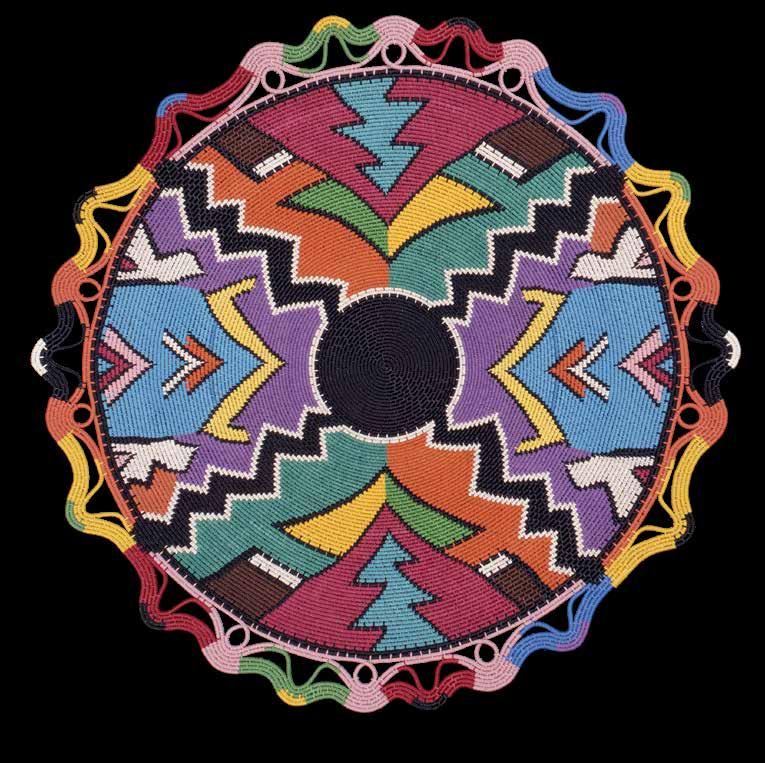
Weaving Meanings takes visitors on a chronological journey through seven themed zones, from the originality of the Zulu night guards, to the artistic response to apartheid, to the art form’s optimistic post-apartheid flourishing. That journey reflects Arment’s passion for the art form in assembling a comprehensive, world-class collection.
“Jim and I have been traveling to Africa for over 30 years, and our visits overlapped with the development of this art form and the emergence of so many talented master weavers,” says Arment. “We built this collection over many years and are so excited to be sharing the art of telephone wire with the museum and the world.”
To support the Museum of International Folk Art, contact Laura Sullivan at 505.216.0829 or laura@museumfoundation.org.
The exhibition culminates with complex masterpieces that have captured the international spotlight. Video interviews shed further light on the artists' experiences, offering a glimpse into their lives and the wirework creation process.
"Working closely with South African artists and filmmakers and consulting a team of Indigenous Knowledge Experts—artists, community members and others with deep connections to wire-weaving communities in KwaZulu-Natal, South Africa—ensured the exhibition reflects diverse perspectives,” says guest curator Elizabeth Perrill. “Educational materials designed for South African educators foster international connections around telephone wire art while enriching the MOIFA collection."
Weaving Meanings is supported by the International Folk Art Foundation and Friends of Folk Art with lead support from David Arment and Jim Rimelspach. Other major support comes from Courtney and Scott Taylor, the William H. and Mattie Wattis Harris Foundation, and additional donors to the Museum of New Mexico Foundation's Exhibition Development Fund, including Trisha Wilson, in honor of David Arment; Joan and Steve Grady; and Ginger and Kelly Hardage.
Wire Basket Sneak Peeks
First Look Preview
Friday, November 15
5:30 to 7:30 p.m.
All Member Preview
Saturday, November 16
5:30 to 7:30 p.m.
Michael Mfeke, large wire covered plastic beer pot (detail), 2004. Telephone wire, steel wire and plastic. David Arment Southern African Collection, Museum of International Folk Art. Image courtesy of Andrew Cerino.
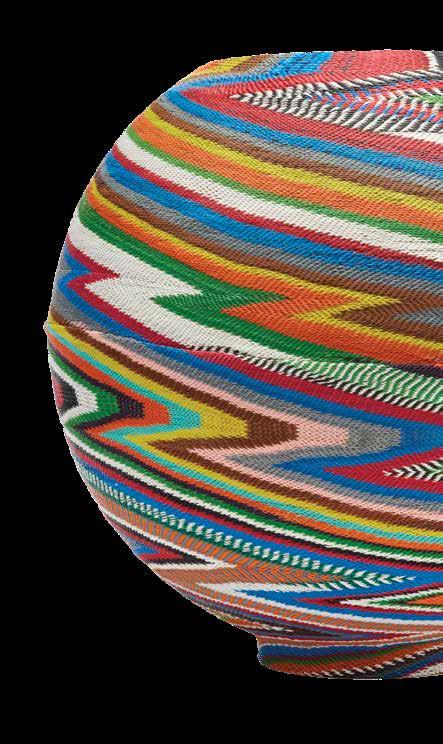
Immerse yourself in Mexican and Indigenous cultural heritage on Saturday, September 21, from 1 to 6:30 p.m. on Milner Plaza at “Extravaganza on Museum Hill,” a fiesta of Mexican and Indigenous food, music, dance and live lucha libre wrestling.
This free, family-friendly event celebrates the Museum of International Folk Art’s popular exhibition, La Cartonería Mexicana: The Mexican Art of Paper and Paste (on view through November 3), and New Mexican Indigenous dance traditions presented by the Museum of Indian Arts and Culture. Visitors will witness lucha libre’s high-flying wrestling acrobatics with their favorite professional luchadores. Kids of all ages will be invited to make their own máscara, or mask. Local food trucks serving paletas, churros and more will also be onsite.
Music and dance performances include Los Machetes, Los Niños de Santa Fe’s adult folk dance ensemble; Jemez Pueblo’s Cloud Eagle Dance Group; Mariachi Euforia; Lightning Boy Foundation hoop dancers; and Tropa Magica’s upbeat fusion of traditional Mexican folk and psychedelic rock.
“Extravaganza on Museum Hill” has been generously underwritten by the Friends of Folk Art. The event is part of the annual Community Day on Museum Hill and features free, all-day admission to both the Museum of International Folk Art and Museum of Indian Arts and Culture.
Visit moifa.org for information on all the day’s activities.
The legacy of the New Mexico Museum of Art’s early-20th-century championing of contemporary artists—including providing studio space for such artists as John Sloan and Gustave Baumann—lives on in new public-facing initiatives at Vladem Contemporary.
“We're committed to making our collections and programs accessible to everyone, especially through the Vladem Contemporary’s dynamic new programs, where we open doors for deeper artist-public interaction,” says Mark White, the museum’s executive director.
The Dee Ann McIntyre in Memory of Scotty McIntyre Artist Studio, for example, recently hosted mixed-media artist Angela Ellsworth in residence. “With focused time, I completed four sculptures, with two now at the Smithsonian,” Ellsworth says. And photographer Alex Traube, who completed his residency in June, adds, “My residency was one of the best things in my professional life. It gave me a chance to create an important body of work while reaching out to the community.”
Alexandra Terry, curator of contemporary art at Vladem Contemporary, says that two other dynamic platforms—the Window Box and Digital Window— "also place artists and the community together in meaningful dialogue." The museum's commitment to inclusivity and emerging artists will soon be seen in the street-facing Window Box with photographer Apolo Gomez's upcoming installation of scrolling LED text panels. The work will “amplify the words of queer activists,” says Gomez, adding that “Institutional support at this level is rare.”
The Fritz Family Digital Window, located on the Van Mabee Plaza, showcases a daily rotating program of short films between 4 and 10 p.m. Viewers may stream the audio through their smart devices, akin to a drive-in movie speaker. Works by Madelin Coit, Susanna Carlisle and Bruce Hamilton are currently on view. Rounding out these offerings and located on the Covered Terrace in Memory of Edward Hastings and Gino Barcone is Astral Array, a permanent outdoor LED light installation by internationally acclaimed Albuquerque-based artist Leo Villareal.
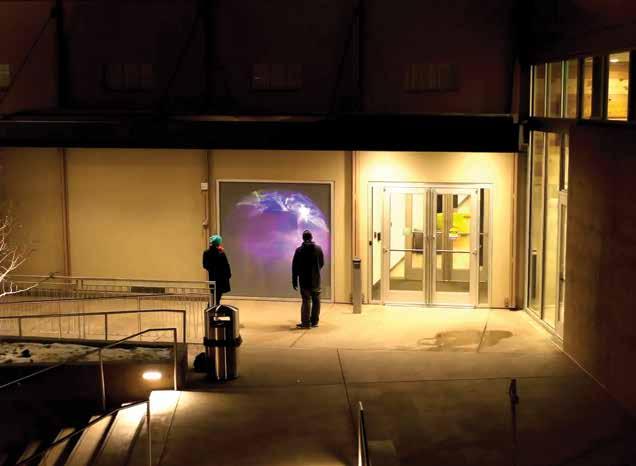
“The museum also plays a vital role in documenting and preserving the artistic legacy of our time,” says Christian Waguespack, the museum’s head of curatorial affairs and curator of 20th century art. He cites the museum’s recent oral history project, which is assembling video interviews with many of the artists featured in the exhibition Off-Center: New Mexico Art: 19702000. These, he says, are “vital primary source material, preserving contemporary artists’ legacies for the next generation of researchers.”
Off-Center artists Susanna Carlisle and Bruce Hamilton, husband-andwife collaborators whose work is featured in the Fritz Family Digital Window, credit Vladem Contemporary “with creating more opportunities for New Mexico artists to showcase their work, significantly impacting the state's
To support the New Mexico Museum of Art, contact Alex Wilson at 505.216.0826 or alex@museumfoundation.org.
contemporary art scene.” And museum supporters Barbara Doroba-Ogg and Michael Ogg (a Museum of New Mexico Foundation trustee) add that Off-Center’s “compelling juxtaposition of works by more than 125 artists from 1970 to 2000 affords viewers a unique opportunity to engage with the extraordinary vitality and diversity of that era."
Contemporary Chicano sculptor Luis Tapia kicked off the Off-Center "Final Friday Artist Talks” program in June with a conversation with Waguespack. Funded by Pat and Jim Hall, the once-monthly series lets the public engage directly with contemporary artists, such as Constance DeJong (September) and Peter Sarkisian (October). In 2025, featured artists will be Jo Whaley (January), Gail Rieke (February), Charlene Teters (April) and others. Additionally, Maria and Ed Gale’s Gale Family Foundation is underwriting a different series of panel discussions and artist talks scheduled to start later this fall and running through the Spring of 2025.
Finally, the museum’s educational outreach programs will increase accessibility to school-age kids through new digital initiatives, including virtual museum tours. The new Railyard Compass Program, a collaborative project with SITE Santa Fe and Violet Crown Cinema, introduces 7thgraders to contemporary art.
"Here at the New Mexico Museum of Art, we believe art is a powerful tool for connection and understanding,” says White. “It is through private support through the Museum of New Mexico Foundation that together we can ensure these programs become a vibrant cornerstone of Santa Fe's cultural landscape."

Line by Line, on view at the New Mexico Museum of Art’s historic downtown Plaza Building through February 9, 2025, explores one of art's most ancient elements—the line—through works by over 70 artists from the 1920s to the present.
The primal act of mark-making, from a child's scribbles to ancient petroglyphs, inspired exhibition curator Katherine Ware to select a diverse range of artworks from the museum's collection, including pieces never before seen.
"The simplicity of the line allows for individual interpretation,” says Ware. “There's no deep message.”
Juxtaposing New Mexico-based artists with other prominent 20th-century figures, the show highlights the state’s vibrant artistic community’s engagement with the wider art world. The approach has such artists as Harmony Hammond, Raymond Jonson, David Scheinbaum and Ramona Sakiestewa sharing gallery space with Sol LeWitt, Robert Motherwell, Frank Stella and Piet Mondrian.
The stark beauty of New Mexican landscapes resonates with artists’ desire for clean lines and uncluttered compositions, Ware says. For example, Johnnie Winona Ross’s San Solomon Seeps 05 features alternating strong horizontal lines that evoke geological formations. And artist Tim Jag’s smudged graphite lines in Drawing Construction #15 are “so thick that it sheds,” Ware says. The work departs from the machine-like precision of Sol LeWitt or Frank Stella, inviting viewers to engage with the physicality of the line itself.
If asked to name the smell they most closely associate with New Mexico, most New Mexicans would probably say “roasting green chile in late summer.” The smokey char and vegetal notes fill the air for weeks. Then, just as chile-roasting season ends, piñon smoke begins to waft from fireplaces around the state.
Such evocative scents are part of Forks in the Road: A Diner’s Guide to New Mexico, a newly opened immersive exhibition at the New Mexico History Museum. It’s the first segment of a three-year project about New Mexico’s culinary heritage.
Guest curator Johnny Vee (aka John Vollersten) and a group of local food writers worked with historic restaurants throughout the state to gather stories of famous food families, beloved recipes, and memorable moments that residents and visitors have experienced in these eateries.
“The foods we love—that we dine on, talk about, write about and read about—play a major role in our happiness and sense of place in society,” Vollersten writes in his curator’s statement. “A curiosity about the origins of our local gastronomy encourages us to travel around the state to source the juiciest green chile cheeseburger, the plumpest chile relleno and the puffiest sopaipilla.”
Forks in the Road stirs memories and stimulates tastebuds while educating visitors about the histories of the featured restaurants and how they reflect the unique landscapes, traditions and identities of particular communities, says Catherine Trujillo, deputy director of the New Mexico History Museum. “We tell the stories of the families and individuals who built and sustained these restaurants, highlighting their resilience, passion and contributions to the state’s economy.”
Opposite: Postcard of the Hotel Castañeda, Las Vegas, New Mexico, ca. 1905. Palace of the Governors Photo Archives, Neg. Number 087172.
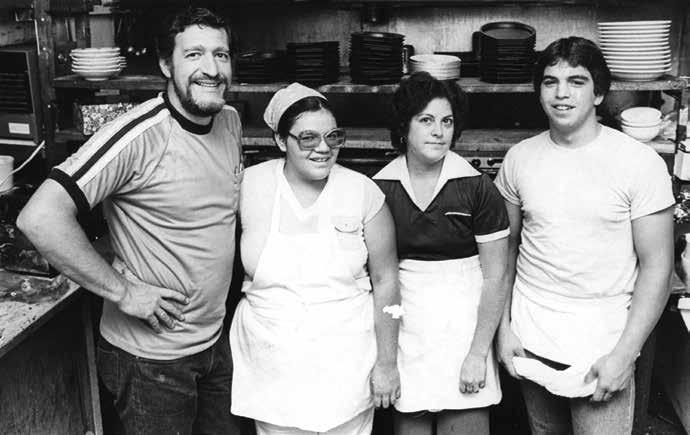
staff
Forks in the Road is on view in Room 15 of the Palace of the Governors, one of the newly renovated spaces in Santa Fe’s (and the nation’s) oldest public building. Restaurants are presented on a large state map that people press to hear recorded stories that diners called in to the museum.
“We received dozens of calls. One was from a woman whose memory was of her 10th birthday, when her mother took her to La Placita Dining Rooms in Albuquerque,” Trujillo says. “She’d never been to a restaurant before, and it was so memorable that it became a family tradition. Whenever any of her siblings turned 10, they went to the same restaurant.”
La Placita, which opened in 1931 and closed in 2020, is one of many legendary restaurants that will live on through this exhibition. And at least one restaurant is notable for being brought back to life. Fred Harvey opened the Hotel Castañeda in Las Vegas, New Mexico, in 1898 as a luxury hotel and restaurant for train travelers. It closed in 1948.
To support the New Mexico History Museum, contact Asya G. Beardsley at 505.216.1199 or asya@museumfoundation.org.
“Following decades of decay and disrepair, the hotel was bought and painstakingly restored by preservationists Allan Affeldt and his wife, artist Tina Mion,” food writer Lynn Cline writes in the exhibition notes. “Re-opened in 2019, the hotel is once again a vibrant gathering place where travelers and locals dine on food and experience America’s great railroad era.”
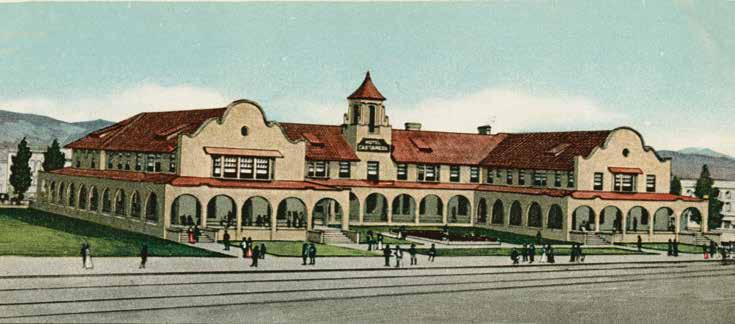
Other famous spots include Tia Sophia’s in Santa Fe, established in 1975; Hi-D-Ho Drive In, in Alamogordo (1970); The Owl Bar and Café in San Antonio (1945); and La Posta de Mesilla (1939).
“What began as one room with dirt floors and four tables now boasts 13 dining rooms, a cozy bar with more than 100 tequilas, an aviary where guests are welcomed by chatty parrots and cockatoo, and New Mexico’s only piranha fish tank,” Vee says of La Posta. “Though the menu is listed as Mexican, La Posta’s cuisine is pure New Mexican, featuring local ingredients including Hatch chile, pecans from nearby fields and honey from down the road.”
Visitors to Forks in the Road are transported by smell, taste, sight, touch and sound, including music. A replica vintage jukebox plays food-inspired music whose playlist
This summer, the New Mexico History Museum launched New Mexico Showcase, a new exhibition series highlighting historic objects from the museum’s collections. It’s the first of an ongoing rotation of annual shows, and your support is needed to keep the selection fresh and informative. Private gifts via the Museum of New Mexico Foundation will support object conservation, preparation of custom mounts, case design, text development and installation.
spans many eras and genres. An interactive dining nook is perfect for selfies.
“I’m delighted to join the museum as a guest curator after working in New Mexico as a chef, teacher and food writer for 30 years,” Vollersten says. “I promise that museum visitors will be deliciously educated and entertained by Forks in the Road.”
The museum’s three-year food heritage project is being supported by private gifts via the Museum of New Mexico Foundation. A total of $150,000 is needed for exhibition development, installation and related programming. Gifts for the project will be matched dollar-for-dollar by a generous bequest to the museum from the late Charles and Mara Robinson.
This first installation, Everyday Odysseys: Relics of Life and Adventure, explores how ordinary objects have shaped the state’s rich and diverse history. Viewed through the lens of curiosity and imagination, it’s a journey through the iconic and the commonplace. Works on view in this and installations to come will include recent acquisitions, staff picks, public favorites from previous popular installations, works by noteworthy artists and photographers, and more.
As Coronado Historic Site presents its 21st annual Fiesta of Cultures from 10 a.m. to 5 p.m. on October 19, site staff is aiming to be even more inclusive than ever before.
“We hope this year’s more inclusive entertainment draws a bigger crowd than last year’s 1,500 attendees, including people who don't usually visit cultural attractions,” says regional manager Katrina Gallegos.
Coronado’s ancient Kuaua Pueblo ruins, unique reconstructed square kiva and 14 of the finest pre-contact kiva murals in North America have long been the central draw for fiesta visitors. The Museum of New Mexico Foundation's Members' Morning from 9 to 10 a.m. will feature coffee and pastries and an exclusive kiva tour. This year’s event also expands its celebration to better reflect Albuquerque's ethnic diversity through music, food, arts and crafts vendors, and other activities.
Albuquerque's growing Asian population—estimated at 10% of the city’s residents—will be represented by colorful Vietnamese Van Hanh Lion Dancers, whose traditional dances are believed to bring good luck and prosperity. Meanwhile, the Wilde Bunch, Albuquerque's LGBTQ+ square dance club will demonstrate the do-si-do tradition of square dancing in a city that boasts an enviable Human Rights Campaign score of 91/100.
Son Como Son, the city’s premier salsa group, whose performances the Albuquerque Dance Examiner describes as "the reason [you] can't sit down," will bring the salsa beat to the festivities. And Acoma Pueblo's renowned Pueblo Enchantment Dancers will share their culture through traditional and contemporary dances, including the iconic Buffalo Dance promoting peace and unity.
This year's fiesta again features a community ofrenda, or memorial altar, overseen by Mariana Sabino Salazar of the University of New Mexico’s Latin American and Iberian Institute. Salazar will lead discussions about ofrendas during the fiesta. Visitors can contribute photos or mementos of loved ones by contacting Coronado Historic Site. The ofrenda will be on display through Day of the Dead on November 2.
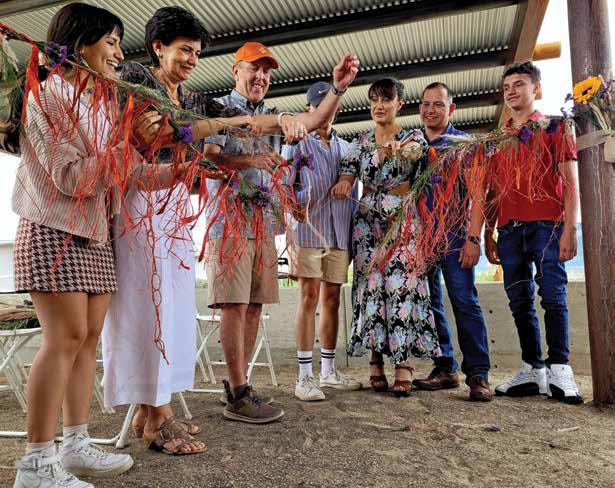
The region’s animal population will also be part of the fun, including cuddly llamas and majestic rescue birds. Among the highlights is Matt Barbour’s flock of heritage turkeys. Barbour, deputy director of historic sites, says he will discuss “the turkey’s important role in Native culture,” including how archaeologists identified a turkey pen at Coronado.
“Animal remains suggest [turkeys] were well cared for by the people of Kuaua,” says Barbour. “A visit to Coronado Historic Site is a great first step in understanding that history.”
Coronado Historic Site is located at 485 Kuaua Road in Bernalillo. For information about all the day’s events, visit nmhistoricsites.org/Coronado.
To learn about Fiesta sponsorship opportunities contact Asya G. Beardsley at asya@museumfoundation.org or 505.216.1199.
There’s all-day fun for everyone at Los Luceros Historic Site’s annual Harvest Festival on Sunday, September 22, from 10 a.m. to 4 p.m. Activities include music and dance, food trucks, arts and crafts, farm vendors, history tours and more.
Listen to site staff tell stories about this picturesque 148-acre ranch located north of Alcalde on the east bank of the Río Grande. Learn about its 18th-century Hacienda, the bosque, the orchard and the people who have called the land home over the centuries. And pick apples —including the heritage Red Delicious, which is much sweeter than the store-bought variety.
The Cultures & Creators Arts Festival features traditional and contemporary artists from Española, Taos and Santa Fe, in partnership with the Northern Río Grande National Heritage Area. And kids won’t want to miss authors (and brothers) Carlos and Paul Meyer’s tale of an enchanted cookie that transforms a boy into a calf. The young ones will also enjoy craft activities and a visit from the New Mexico Wildlife Center's Animal Ambassadors at 10:30 a.m.
Curious minds of all ages will want to explore the mobile Wonders on Wheels special exhibition, curated by the New Mexico Farm & Ranch Heritage Museum in Las Cruces, which dives deep into New Mexico's rich food traditions (with tasty, take-away recipes) and agriculture. Become a mini-botanist and examine corn, beans and chiles under a microscope, then plant your own seeds to germinate at home.
Los Luceros Historic Site is located at 253 County Road 41 in Alcalde. Visit nmhistoricsites.org/los-luceros for more information.
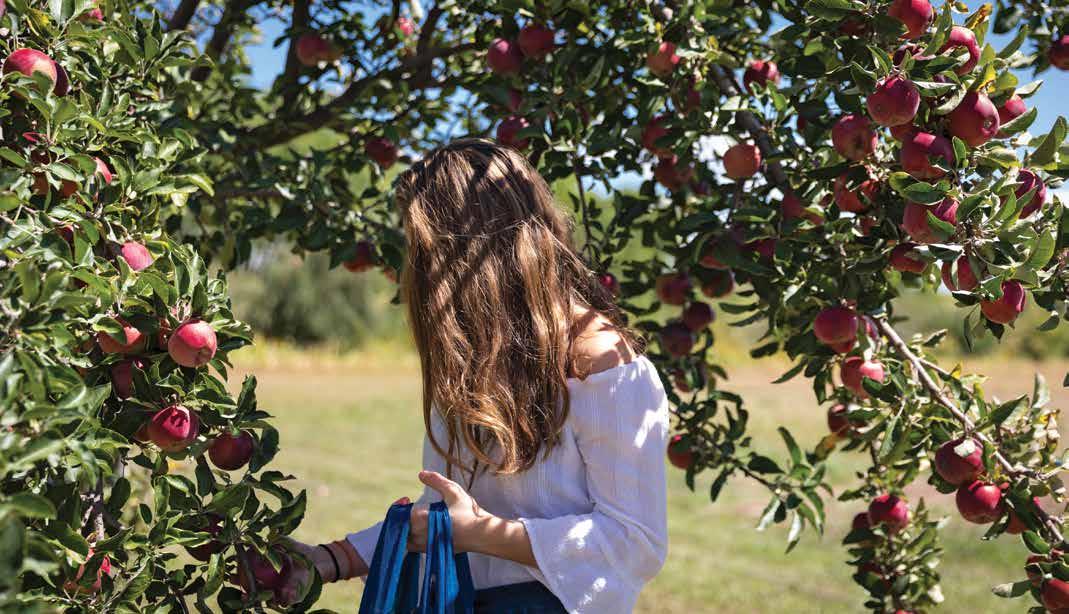
Consider the Office of Archaeological Studies a scientific detective agency.
In offices at the Center for New Mexico Archaeology, a dedicated team of researchers work in multiple laboratories, piecing together objects from New Mexico’s archaeological past to inform our present. At once employing cutting-edge tools in the radiocarbon sampling lab, undertaking important research in the archaeomagnetic lab, and engaging in complementary fieldwork, their investigations of the past help clarify how we tackle presentday challenges like climate change.
The expertise of OAS researchers is world-class and attracts internationally significant projects. It’s also put to use to analyze artifacts from the contract archaeology projects that help support this nonprofit enterprise division of the Museum of New Mexico system.
Marvin Rowe, who heads up the Low Energy Plasma Radiocarbon Sampling Laboratory, pioneered a groundbreaking technique that Archaeology Magazine in 2010 called "one of the most important discoveries in decades." Considered to be the most elaborate and precise dating systems developed to date, radiocarbon dating determines an object’s age by precisely measuring the decay of a specific carbon isotope trapped within. It requires just a minuscule sample—as little as 30 millionths of a gram of carbon—ensuring the artifacts are not harmed.
If radiocarbon dating can't be used, then OAS lab supervisor Shelby Jones takes over in the Archaeomagnetic Laboratory, where an object’s magnetic signature is recorded, much like a fingerprint. This lab is already one of the most complete repositories of North American archived specimens. With new specimens constantly arriving, Jones says, “These labs will soon serve as a research library for scientists across the U.S. and the world.”
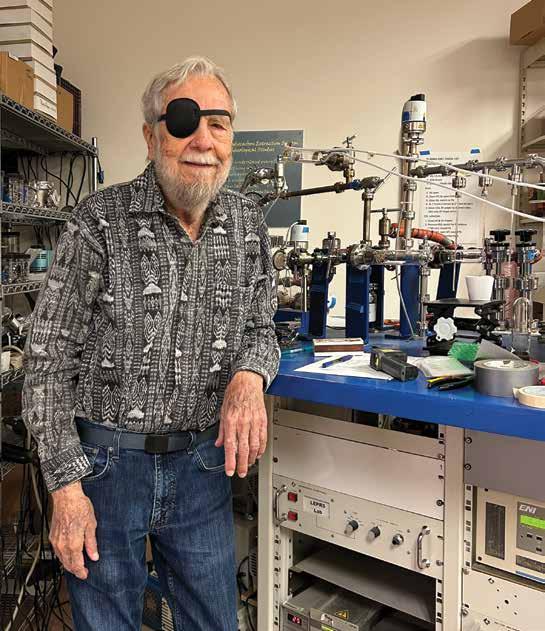
In order to accommodate more materials, a significant upgrade to the lab’s equipment and custom carpentry is underway, though additional private support is needed. Once completed, Jones and OAS will be prepared to utilize a wider range of research techniques.
Meanwhile, Osteology Laboratory supervisor Chandler Buchfink examines skeletal remains, revealing a wealth of information about the lives of people who lived in this region long ago. Buchfink can determine if they were primarily hunters, gatherers or farmers. “Creating these life histories,” he says, “is one of the most important things I do to share the experiences that past peoples faced.” He hopes for funding to acquire new equipment for the lab and reference materials to further refine analyses.
Archaeological field technician Steve Needle has his sights set on the mysteries of Chacoan architecture—and solving them can get high-tech.
To support the Office of Archaeological Studies, contact Lauren Paige at 505.982.2282 or lauren@museumfoundation.org.
Needle envisions developing an interactive archaeological map using powerful software to create a layered repository of diverse data—what Needle describes as a sort of “digital cake.” The project will gather the disparate data in one place, and by zooming in and out from the map, Needle will have access to the information he needs to better visualize, explore and analyze related archaeological information. But without funding for this groundbreaking research, data collection and analysis, and licensing and training on this new software, Chaco’s architectural mysteries will remain.
These labs will soon serve as a research library for scientists across the U.S. and the world.
“We are engaged in truly pioneering work, with local and global applications,” says John Taylor-Montoya, executive director of OAS. “That work would not be possible without private support through the Museum of New Mexico Foundation. Thank you for helping us uncover New Mexico’s rich heritage.”

This spring, the Office of Archaeological Studies was honored to receive a generous $250,000 gift from the Susan S. Martin Charitable Giving Fund.
This meaningful contribution was made in Martin’s memory by her dear friends, Melissa Landon, Diane Blaser and Ellen Heath.
The fund will support OAS research and educational programming in honor of Martin’s deep love for archaeology.
Martin, a longtime Museum of New Mexico Foundation member, was a passionate botanist and birder. Her journey into the field began with a special Girl Scout group, where she participated in digs led by Bertha P. Dutton, a renowned Museum of New Mexico anthropologist and ethnologist who specialized in the American Southwest and Mesoamerica. The group, often covered in dust from their fieldwork, affectionately dubbed themselves "Dutton's Dirty Diggers."
“With this generous gift, we can take our ideas of what we would like to do and turn them into reality,” says OAS executive director John Taylor-Montoya. “We will update our ethnobotany lab for researchers and students and for outreach programming and supplies—all areas of interest to Susan Martin.”
In addition to OAS, the Museum of Indian Arts and Culture and Laboratory of Anthropology received two gifts from the Susan S. Martin Charitable Giving Fund.
The Santa Fe New Mexican has been a corporate partner of the Museum of New Mexico Foundation for so long that its owner, Robin Martin, can’t recall when the partnership began.
“I’m sure it’s since the beginning,” she says. “My father [former New Mexican editor and publisher Robert McKinney] and mother were great supporters of the Museum of Art, and my mother-in-law, Barbara Martin, was on the Women’s Board for ages. And of course, the paper has been very supportive in its coverage of the museums, especially in Pasatiempo.”
The New Mexican’s publisher, Patrick Dorsey, says that the independent daily newspaper, which celebrates its 175th anniversary this year, has been involved since the Foundation’s founding in 1962.
“We consider our support of the Foundation to be part of our responsibility in serving Santa Fe and all of New Mexico,” he says. “The newspaper was founded in 1849, and our history is intertwined with New Mexican statehood and the establishment of the entire museum system.”
The newspaper’s Premier-level partnership, with more than $25,000 in in-kind contributions, features many benefits, including free museum admission, invitations to members-only Foundation events and prominent forms of recognition.
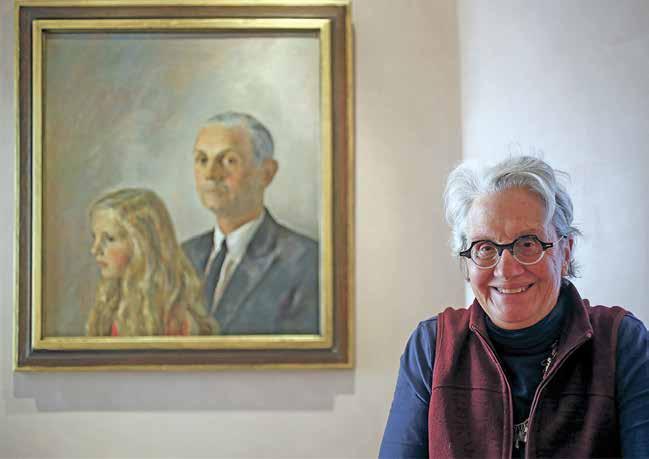
Martin first visited the Palace of the Governors when she was four or five years old, to see an exhibition about the 1907 Puye Cliff Dwellings excavation. As she grew up, she developed an appreciation for the state historic sites, especially the unparalleled view of the Sandia Mountains from the porch of the John Gaw Meem building at Coronado Historic Site. But her lifelong connection to New Mexico and the museums is best conveyed by the inclusion of her own childhood flamenco dress in Flamenco: From Spain to New Mexico, which was on view at the Museum of International Folk Art from 2015 to 2017.
As owner of Santa Fe’s paper of record, Martin attends many special events through the Foundation, and “I always take out-of-town visitors to the museums,” she says. “The [now-closed] exhibition I saw lately that I got most excited for was Ghhúunayúkata/To Keep Them Warm, about Alaska Native parkas, at the Museum of International Folk Art. That was the most amazing thing I’ve seen—the way they were sewn with the tiny pieces of skin that people put together, the beauty of the design and the technique. I told everybody I could think of to go see it.”
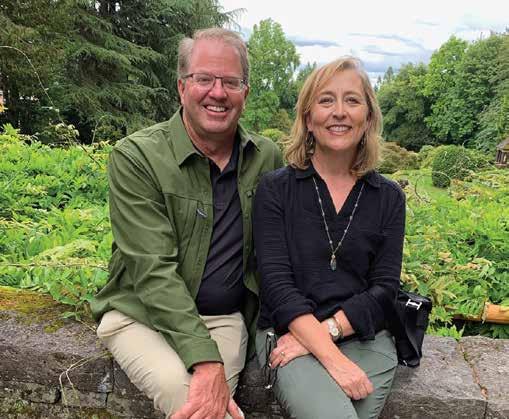
Christine and Drew McDermott's passion for their home state has motivated them to support the Museum of New Mexico system. In doing so, they have enjoyed exploring the museums and historic sites while making long-lasting friends with Circles members, museum professionals, and Museum of New Mexico Foundation staff and trustees.
“As native New Mexicans, Drew and I enthusiastically support the Museum of New Mexico Foundation and the museums which promote and showcase New Mexico’s arts, culture and history,” says Christine McDermott, a Foundation trustee and partner at Avalon Trust, a Foundation corporate partner.
In a unique giving approach, the McDermotts blended their charitable contributions to support their interests, provide them with tax benefits, and have a lasting influence on the quality of life in their community. In addition to giving to the Foundation's annual fund via their donor advised fund and as members of The Circles, they have made legacy gifts to the Foundation and the New Mexico History Museum Endowment Fund through their estate plan. By using a combined giving strategy, the couple is making impactful gifts in their lifetimes while ensuring long-term support for the cultural life of their community for future generations.
If you are interested in making a gift that offers tax benefits today and has an impact in the future, a blended gift might be right for you. Contact Laura Sullivan at laura@museumfoundation.org or 505.216.0829. Or visit mnmflegacy.org to learn more.
Top: Drew and Christine McDermott. Photo courtesy the McDermotts.
MEMBERSHIP
Support the Museum of New Mexico Foundation in delivering essential services to our 13 partner cultural institutions while offering enjoyable member benefits.
THE CIRCLES
Participate in a series of exclusive events while providing leadership-level support.
CIRCLES EXPLORERS
Support and explore the art, culture and history of New Mexico through active, adventurous, and educational cultural excursions and experiences.
Support the museums through your business and receive recognition and member benefits for your business, clients and employees.
ANNUAL FUND
Provide critical operating support for the Museum of New Mexico Foundation to fulfill its mission on behalf of our 13 partner cultural institutions.
EXHIBITIONS
Support exhibitions, related programming and institutional advancement at the division of your choice.
EDUCATION
Fund museum education and public outreach programs at our four museums, eight historic sites and the Office of Archaeological Studies.
PLANNED GIVING
Provide a long-lasting impact at our 13 partner cultural institutions through a bequest, beneficiary designation, charitable gift annuity, charitable remainder trust or gift of art.
Establish a new fund, or add to the principal of an existing fund, to provide a reliable source of annual income that sustains a variety of cultural programs and purposes.
Give to special campaign initiatives designed to fund a range of capital expansions and programming advances throughout the Museum of New Mexico system.
For more information, visit museumfoundation.org.

at the Lynn Godfrey Brown Shop in the Museum of International Folk Art